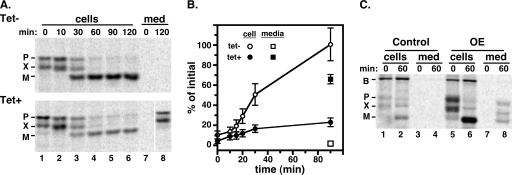FIG. 3.
Effect of Tbμ1 silencing on trypanopain trafficking in PCF trypanosomes. (A) After culture without (Tet−) or with (Tet+) induction of dsRNAi synthesis, procyclic Tbμ1 cells were subjected to pulse-chase radiolabeling as described in Materials and Methods. Trypanopain polypeptides were specifically immunoprecipitated from equivalent cell extract and medium (med) fractions at the indicated chase times and analyzed by SDS-PAGE/phosphorimaging. The mobilities of precursor (P) and mature (M) trypanopain and the uncharacterized trypanopain-related polypeptide (X) are indicated. All lanes contained 107 cell equivalents. The vertical white line in the lower blot indicates intervening lanes that were digitally excised for the sake of presentation (all remaining lanes are from the same exposure). (B) Relative amounts of cell-associated and secreted trypanopain in control (tet−) and silenced (tet+) cells were quantified by phosphorimaging. For cell-associated trypanopain (circles), the mature species was quantified as a percentage of all initial species (P + X + M). For secreted trypanopain (squares), all species (P + X + M) were quantified as a percentage of all initial species (P + X + M). The data represent means ± SEM for triplicate experiments. (C) Control and trypanopain-overexpressing (OE) cell lines were pulse-chase radiolabeled, and trypanopain (P, X, and M) and BiP (B) polypeptides were simultaneously immunoprecipitated from equivalent cell extracts and medium fractions at the indicated chase times. The BiP polypeptide served as an internal control for equal loading of cell samples and as a negative control for secretion. Samples were analyzed as for panel A; all lanes contained 107 cell equivalents.

